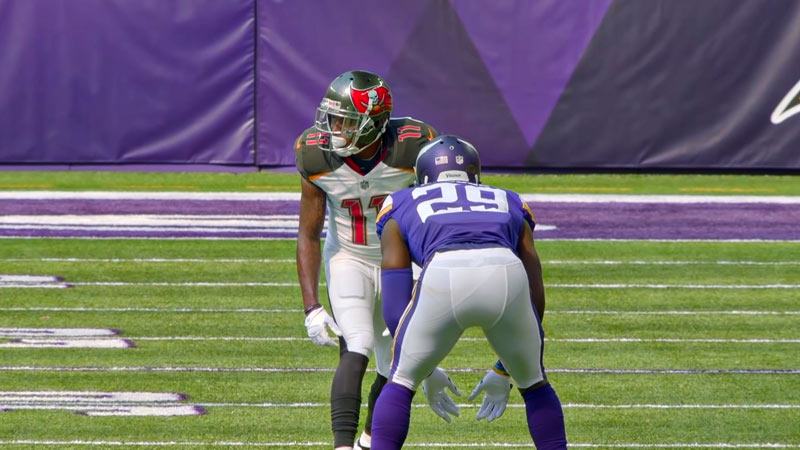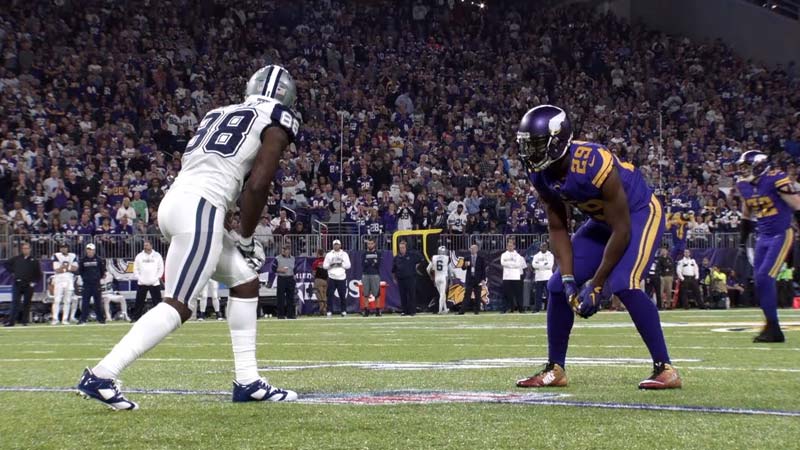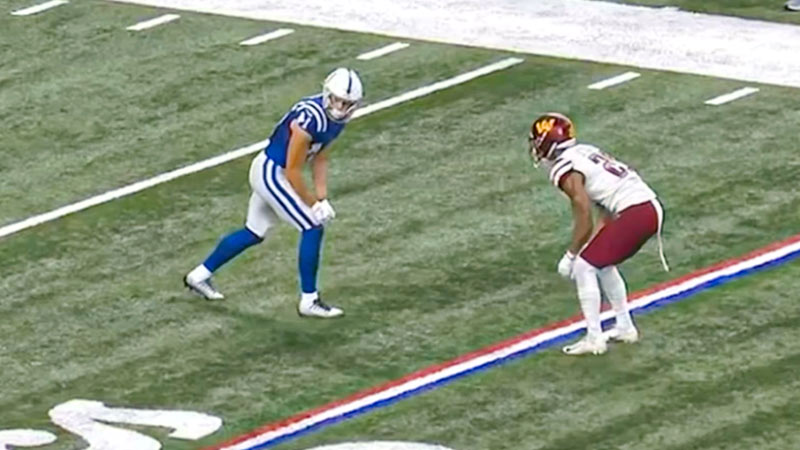In the dynamic world of American football, the playbook is an ever-evolving canvas of strategies and plays designed to outsmart opponents. Among the myriad of tactics, the football post route stands out as a potent weapon for teams seeking to strike deep and seize control of the game.
In this comprehensive guide, we delve into the intricacies of football post routes – from their execution on the field to their impact on the course of a game.
Whether you’re a dedicated fan, a player, or simply intrigued by the strategic beauty of the sport, this exploration of football post routes promises insights that unveil the secrets behind this electrifying play. Stay focused.
What Is Football Post Routes?
A football post route is a pass route commonly used by wide receivers in American football. It is designed to create a scoring opportunity by exploiting the deep middle area of the field. In a post route, the receiver initially angles diagonally toward the center of the field after taking a few steps forward.
This deceives defenders and often creates separation between the receiver and the cornerback covering them. Once the receiver gains separation, they make a sharp cut towards the goalpost, aiming to catch the football in stride for a potential touchdown.
The post route requires precise timing between the quarterback’s throw and the receiver’s route to be successful. It is a strategic play designed to stretch the defense and capitalize on defensive vulnerabilities in the middle of the field.
When to Use Post Routes in Football?
Post routes are often used in specific situations to take advantage of defensive coverages and create big plays in American football. Here are some scenarios when post routes can be effective:
Single High Safety Coverage
When the defense employs a single high safety, it leaves the middle of the field vulnerable. Post routes can exploit this by forcing the safety to cover a large area, allowing the receiver to cut toward the goalpost and potentially catch the ball deep downfield.
Man-to-Man Coverage
Against man-to-man coverage, a well-executed post route can create separation between the receiver and the cornerback. By angling towards the center before cutting towards the goalpost, the receiver can create a sudden change of direction that makes it difficult for the cornerback to keep up.
Play Action Passes
Post routes can work effectively off play-action passes. The play-action fake to the running back can draw the linebackers and safeties forward, creating a window of opportunity for the post route to exploit the open space behind them.
Deep Pass Situations
When a team needs to gain substantial yardage quickly, such as in two-minute drills or when trailing late in the game, post routes can be used to stretch the field vertically and create potential scoring opportunities.
Receiver’s Skillset
Post routes are best suited for receivers with good speed, acceleration, and the ability to make sharp cuts. If a team has a receiver with these attributes, utilizing post routes can capitalize on their strengths.
Field Position
Post routes are more effective when the offense is positioned near midfield or in opponent territory. This allows for a deeper throw and increases the chances of turning a successful catch into a significant gain or touchdown.
Defensive Tendencies
Studying the opponent’s defensive tendencies can reveal opportunities to exploit with post routes. If the defense tends to leave the middle of the field open or struggles with covering deep passes, post routes can be a valuable weapon.
Down and Distance
Post routes are often used on early downs when the offense has a good chance of capitalizing on a deep pass. However, they can also be employed in critical third-down situations to move the chains or gain a substantial chunk of yardage.
It’s important to note that the success of a post route depends on the quarterback’s timing and accuracy, the receiver’s route-running ability, the offensive line’s pass protection, and the overall game situation.
Strategies of Football Post Routes

Executing effective football post routes requires a combination of strategy, timing, and teamwork. Here are some key strategies for both receivers and quarterbacks when using post routes:
For Receivers
- Release Technique: Use a quick release off the line of scrimmage to create separation from the cornerback. This initial burst of speed can set up the post route effectively.
- Diagonal Angle: Start by angling diagonally towards the center of the field after a few strides. This movement can make the cornerback think you’re running a different route, creating space for the post-cut.
- Change of Direction: Execute a sharp and decisive cut toward the goalpost. Sell the fake by dropping your hips and shoulders as if you’re changing direction, forcing the cornerback to react and potentially lose a step.
- Maintain Speed: After making the cut, maintain your speed to get to the open space quickly. The goal is to catch the ball in stride for maximum yardage.
- Tracking the Ball: Keep your eyes on the quarterback as you make your cut. Adjust your speed and positioning based on the flight of the ball to ensure you’re in the optimal spot for the catch.
- Physicality: Be prepared for contact from defenders, especially as you enter the middle of the field. Use your body to shield the ball and maintain possession through contact.
For Quarterbacks
- Pre-Snap Read: Analyze the defensive alignment and coverage before the snap. Identify if the middle of the field is open or if the safety is shaded towards one side.
- Timing: Develop a strong rapport with your receiver to establish the timing of the route. The throw needs to be released just as the receiver makes the cut, allowing the ball to arrive in the right spot as they reach the open space.
- Eye Manipulation: Look off the safety or cornerback on the opposite side of the field before throwing the post route. This can freeze the defender and create a bigger window for the throw.
- Throwing Trajectory: Aim to throw the ball over the top of the cornerback and in front of the safety. The trajectory should allow the receiver to make a play on the ball while reducing the risk of interception.
- Velocity and Placement: Deliver the pass with enough velocity to reach the receiver quickly, but also with enough touch to allow for a catchable ball. Aim for the receiver’s outside shoulder to further protect against interceptions.
- Adjust Based on Coverage: If the safety rotates towards the middle, be prepared to adjust the throw towards the sideline or opt for a different target. Reading the coverage post-snap is crucial.
- Pocket Awareness: Ensure you have sufficient time and protection from the offensive line to execute the deep throw. Being under pressure can affect the accuracy and timing of the pass.
The success of football post routes relies on the synergy between the receiver and the quarterback, along with their ability to read the defense and adjust accordingly.
Defending Against Football Post Routes

Defending against football post routes requires a combination of sound defensive techniques, communication, and strategic awareness. Here’s a guide on how to defend against post routes effectively:
Cornerback
- Press Coverage: At the line of scrimmage, use press coverage to disrupt the receiver’s timing and release. Jamming the receiver can throw off their route and prevent them from gaining a clean release.
- Positioning: Maintain inside leverage on the receiver to force them toward the sideline. This positioning makes it more difficult for the receiver to cut sharply toward the goalpost.
- Reading the Receiver: Watch the receiver’s initial steps and body language to anticipate their route. Be ready to react if they suddenly break towards the middle for the post route.
- Change of Direction: When the receiver makes the post cut, transition smoothly and stay tight in coverage. Keep your eyes on the receiver’s eyes and hands to avoid being fooled by fakes.
- Recovery Speed: If you’re slightly beaten on the post route, rely on your recovery speed to catch up to the receiver and disrupt the pass.
Safety
- Deep Coverage: As a safety, your primary responsibility is to prevent deep passes. Read the quarterback’s eyes and movements to anticipate where the ball is going.
- Alignment: Position yourself to cover the deep middle of the field. If there’s a single high safety, focus on staying centered to help defend against post routes on both sides.
- Depth and Timing: Gauge the depth of the post route and time your movement accordingly. You want to be in a position to contest the catch without allowing too much separation.
- Communication: Continuously communicate with your cornerback and other defensive backs to ensure everyone is aware of their assignments and the offensive formation.
Linebackers
- Zone Drops: If the defense is in zone coverage, linebackers might have responsibility for the deep middle. Drop into your zone and read the quarterback’s eyes to react to potential post routes.
- Depth and Awareness: Maintain proper depth to cover any routes that enter your zone. Be ready to adjust your positioning based on the movement of the receivers and the quarterback.
- Collaboration: Work with the safeties and cornerbacks to provide layered coverage. This prevents receivers from finding open pockets between defenders.
Defensive Line
- Pass Rush: A strong pass rush can disrupt the quarterback’s timing and accuracy on deep throws. Apply pressure to force the quarterback to release the ball earlier than desired.
- Containment: Defensive linemen should maintain their rush lanes to prevent the quarterback from escaping the pocket and extending the play.
General Strategies
- Film Study: Study the tendencies of the opposing team and their preferred situations for using post routes. This knowledge can help you anticipate and react effectively during the game.
- Mix Up Coverages: Use a mix of man-to-man and zone coverages to keep the offense guessing and prevent them from exploiting a consistent defensive approach.
- Pre-Snap Movement: Shift defensive coverages and alignments just before the snap to confuse the quarterback and disrupt the timing of the post route.
- Physicality: Be physical with receivers within the legal limits. Jamming them at the line of scrimmage and maintaining contact during the route can disrupt the timing and rhythm.
Defending against football post routes requires a collective effort from the entire defensive unit, effective communication, and the ability to read and react to offensive actions.
Impact of Post Routes on American Football

Post Routes have a significant impact on American football due to their potential to create big plays, stretch the field, and exploit defensive vulnerabilities. Here are some ways in which post routes impact the game:
Big Play Potential
Post routes are designed to create explosive plays by targeting the deep middle of the field. Successfully executed post routes can result in long gains or touchdowns, quickly changing the momentum of a game.
Vertical Stretch
Post routes force defenses to cover the entire length of the field, vertically stretching their coverage. This opens up opportunities for other routes underneath or along the sidelines as defenders may be preoccupied with the deep threat.
Defensive Adjustments
To defend against post routes, defenses often need to assign extra attention to the deep middle, altering their coverages and alignments. This can create favorable matchups in other areas of the field that the offense can exploit.
Exploiting Single High Safety
Post routes can capitalize on defensive schemes that rely on a single high safety for deep coverage. By putting pressure on that safety, the offense can force them to choose between covering the post route or other deep threats.
Play Action Effectiveness
Post routes complement play-action plays, as they can draw linebackers and safeties forward, creating a void in the middle of the field. This allows the quarterback to exploit the open space with a deep throw.
Two-Minute Drills
Post routes are often used in hurry-up situations or two-minute drills when the offense needs to quickly gain substantial yardage. Their ability to cover a lot of ground in a short amount of time makes them an attractive option in these scenarios.
Defensive Adjustments
When a receiver consistently succeeds with post routes, defenses might shift their coverage to provide safety help over the top. This adjustment can open up other areas of the field for the offense to exploit.
Mind Games
Successfully executing post routes early in a game can force the defense to respect the deep threat, potentially creating opportunities for shorter routes or misdirection plays.
Quarterback-Receiver Chemistry
Developing a strong connection between the quarterback and the receiver running post routes is essential. This chemistry leads to precise timing and accurate throws, increasing the chances of success.
Strategic Tool
Coaches use post routes strategically to exploit specific matchups or defensive weaknesses. Their inclusion in a game plan can influence how the defense prepares and adjusts.
FAQs
What is a football post route?
A football post route is a pass route executed by wide receivers to exploit the deep middle area of the field. The receiver starts by angling diagonally towards the center before sharply cutting towards the goalpost, aiming to catch the ball for a potential touchdown.
When should teams use post routes?
Post routes are effective in situations such as single high safety coverage, man-to-man matchups, play-action passes, and critical down-and-distance scenarios. They are especially valuable when teams aim to stretch the field vertically and capitalize on defensive vulnerabilities.
How do receivers execute post routes effectively?
Receivers need to perfect their release technique, change of direction, and tracking skills. A combination of speed, agility, and timing is crucial to creating separation from defenders and catching the ball in stride for maximum yardage.
What strategies do defenses employ to counter post routes?
Defenses defend against post routes by using techniques such as press coverage, reading the receiver’s movement, deep coverage alignments, and a mix of coverages. Effective communication among defenders and reading the quarterback’s intentions play key roles.
What impact do post routes have on the game?
Football post routes have a profound impact on the game, including their potential to create big plays, stretch the field, alter defensive strategies, and influence the overall momentum of a match. Their execution and success can significantly shape the outcome of a game.
Wrapping Up
Football post routes are a testament to the strategic brilliance that defines American football. With their ability to create explosive plays, challenge defenses, and ignite the crowd, post routes remain a captivating aspect of the game.
From the calculated movements of receivers to the intricate defensive schemes designed to counter them, this guide has explored the multifaceted world of football post routes.
Whether they result in breathtaking touchdowns or inspire defensive adjustments, post routes continue to leave an indelible mark on the gridiron, making every play an opportunity for excitement and strategic mastery. Thank you so much.







